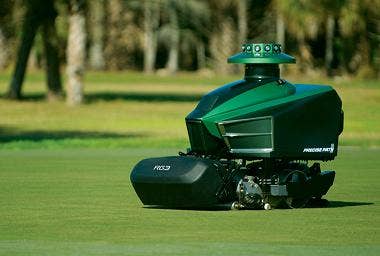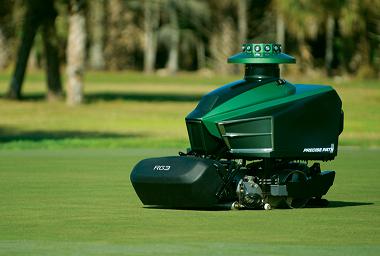Lawnmower Robots Get Millions in Funding, Head Towards the Golf Green

Share
Precise Path just received an additional $4.5 million dollars in funding for their robots that mow grass. According to their recent press release, the Indianapolis based company received a boost in investments and is already staging pilot programs with two major golf course management companies. The Precise Path robot, the RG3, is about the size of a riding mower, and both cuts and rolls golf greens at the same time. Using position tracking the robot can mow a green in a single pass, even in the dark. Not only that, but the accompanying software allows operators to decide the direction and path of the cut, giving the finished grass a customized and pristine look. Eventually the bot could be used to cut company logos in lawns. We've got a series of videos for you below, each highlighting a particular advantage, or limitation, of the robot. Precise Path seems on a steady track towards taking a big chunk of the billion dollar market of golf course mowing, but with a price tag near $30,000 don't expect the RG3 to be on your own lawn anytime soon.
According to Precise Path, there are more than 32,000 golf courses around the world, and the US alone spends $1 Billion in maintaining golfing greens. Much of this grass is mowed by hand, a labor-intensive solution. With robots, golf courses could cut that labor by 75% (one robot operator overseeing 4 robots). In their blog, Precise Path lays out how 4 RG3s could offset more than 90% of their own costs in just a single year. They also portend that the robots may provide tens of thousands of dollars in additional revenue by allowing courses to open earlier because the bots can mow while it's still dark. Those sorts of projected savings are a good indication that automation may be ready to revolutionize golf courses, and a clear example of why Precise Path was able to secure millions of funding in its recent campaign. Here's a video that further explains the financial incentives for augmenting grounds keeping with robotics.
Lawn mowing robots are just part of a larger trend of robots handling maintenance chores, whether they be vacuuming or washing windows. Precise Path likes to compare their RG3 to iRobot's Roomba vacuum. Unlike the Roomba, the RG3 covers an area in a single pass and in a manner decided by the user. However, the real comparison to robot vacuums shouldn't be to the Roomba, but to second generation robot vacuums like Neato's XV-11. In that line-up, you can more clearly see RG3's limitations.
First, the RG3 requires four beacons to be placed on the green it will mow. The robot then uses ultrasonics and infrared sensors to track those beacons and position itself precisely. The first time that an operator uses a RG3 on a green, he or she must manually drive the robot around, mapping out the perimeter of the area. Later, the robot can return and 'fill in' (mow in?) the space automatically. Here's a video of an operator running a RG3 on a typical day.
In contrast to RG3's beacon approach, the XV-11 robot vacuum uses a laser range finder to dynamically map a space and an advanced alogorithm (SLAM) to plan a route each time. The XV-11 approach is more sophisticated, but there are reasons why the RG3 does things the way it does. Golf greens, unlike carpets, are not uniformly flat, and I doubt a currently available laser range finder would be able to find the perimeter of a green as precisely as it needs to. With a $30,000 device you want to make sure that the robot always stays in a safe environment. Having the robot wonder off the green would be dangerous in a course with sand and water traps.
What new innovation does the RG3 bring to the field of maintenance robots? User controlled paths. Actually, the RG3 isn't the first to come up with the idea, but they've implemented it rather well. Using Precise Path software, you can sit on your computer, see all the different greens that the RG3 has in its memory, and decide how each section of grass will be cut. Change the position of turns, the direction of perimeter mowing, etc. The control isn't universal, you can't just draw a line on the screen and have the robot trace it (yet), but the different options seem complete enough. You can also set schedules by day of the week, and your preferences are easily stored on to a flash drive and uploaded to the robot. It's a great concept and one that I wish we would see on robot vacuums soon. Ultimately it's this control over the robot path that will enable you to write messages and draw logos in the grass - something that I'm sure we'll see on the PGA tour in the next few years.
Here's a video highlighting the RG3 software:
Be Part of the Future
Sign up to receive top stories about groundbreaking technologies and visionary thinkers from SingularityHub.


Practically minded readers may be wondering about mowing blades, run times, safety, sound, and other considerations. Well, the blades and roller for the RG3 are all top of the line industry standard according to Precise Path, and seeing as I know nothing about the grass mowing industry I can't comment on whether or not that is true. It certainly looks professional. As for run time, the robot is electrically powered and the three onboard batteries provide up to 3 hours of life in the field. You would think that would make it quiet (and it kind of does) but the RG3 won't be able to sneak up on you. Even if it did, it has a LIDAR obstacle detection system to prevent it from mowing you down.
Here's a demo of the obstacle avoidance:
This video is meant to highlight the turning features of the robot, but it also gives you a good idea of the sound it produces while mowing:
Overall, I'm rather impressed with the RG3 and I imagine that if the pilot programs are successful we'll be seeing a lot more of these systems on golf courses, football fields, and corporate campuses. That means that human mowers may see their jobs change radically in the next five to ten years, if the jobs stay around at all. However, until we build robots that trim bushes, rake sand, and prune trees I don't think that grounds keepers as a whole should be worried. Though, to be honest, it's probably only a matter of time until those robots are created as well. After grass, Precise Path says that it would like to set its sites on snow, airplane runway cleaning, and other outdoor maintenance. We should remember though that high paying occupations, like lawyers, are also facing competition from machines in the form of software programs. Automation continues to tackle jobs at all levels of the economy and how that reshapes the way humans work will be an important part of the 21st century.
Best case scenario - we all have more time to play golf.
Worst case scenario - we all have more time to play golf. (I'm not really a fan of the game).
More videos of the RG3 can be found on the Precise Path YouTube channel.
[image and video credits: Precise Path]
[source: Precise Path]
Related Articles

These Robots Are the Size of Single Cells and Cost Just a Penny Apiece

In Wild Experiment, Surgeon Uses Robot to Remove Blood Clot in Brain 4,000 Miles Away

A Squishy New Robotic ‘Eye’ Automatically Focuses Like Our Own
What we’re reading
